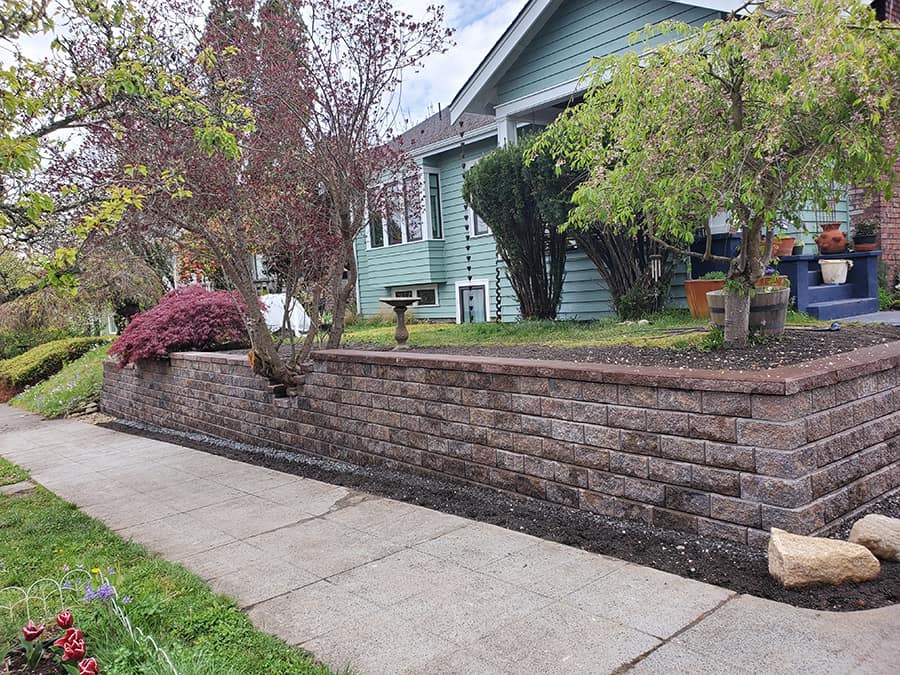🌟 Mr. Lee’s Retaining Wall Process
- Share Your Vision: Tell us how you want your retaining wall to look and function. We’ll recommend the best layout and materials to meet your needs.
- Select the Type: Choose the right retaining wall type, considering height, strength, and the materials required for your project.
- Material Selection: Find the perfect balance between aesthetics, cost, and durability to ensure a wall that complements your landscape.
- Focus on Drainage and Foundation: We prioritize proper drainage and a strong foundation to guarantee long-term stability and performance.
💬 Request a Quote: Share your ideas with us, and we’ll take care of the rest—creating a custom plan and handling every detail to bring your vision to life. Let’s build something extraordinary together! 🌿
Top Retaining Projects:
- Concrete Block Wall: Durable and easy to install, these walls are ideal for stabilizing slopes and preventing soil erosion in garden terraces or driveway retaining walls.
- Natural Stone Wall: Rustic and decorative, perfect for managing erosion while creating raised flower beds or defining landscape edges with natural charm.
- Brick Wall: A timeless choice for controlling soil movement in low garden walls or patio borders, offering both strength and classic appeal.
- Timber Wall: A budget-friendly option for combating erosion, especially effective for supporting slopes and framing garden beds.
📋 Lee’s Retaining Wall Custom Order:
A well-designed retaining wall is essential for controlling erosion, stabilizing soil, and protecting your landscape. Beyond functionality, it can also enhance the beauty of your outdoor space, creating a structure that is both practical and visually stunning.
At Mr. Lee’s, we focus first on erosion control—ensuring proper drainage, a solid foundation, and materials that withstand the test of time. Once stability is addressed, we turn our attention to design, crafting a retaining wall that complements your landscape’s style and enhances its overall appeal.
Our commitment to personalized service means we’ll listen to your goals, guide you in selecting the best materials, and create a custom solution that balances durability and aesthetics. Let’s build a retaining wall that protects and beautifies your yard!

Review Retaining Wall Features & Request a Quote:
| Features | Details |
|---|---|
| Type of Retaining Wall | Segmental Retaining Wall: Interlocking concrete blocks, no mortar, flexible for most projects and curved designs. Gravity Wall: Large, heavy materials like stone, relying on weight for stability, suitable for small projects. |
| Materials | Concrete Blocks: Durable, easy installation, popular for residential and commercial projects. Natural Stone: Rustic, decorative, expensive, time-consuming to install. Brick: Classic look, used for lower-height walls. Timber: Affordable, easy to construct, less durable. |
| Height of Wall | Low (1-3 feet): Garden beds, small slope stabilization. Medium (4-6 feet): Moderate slopes or terracing. Tiered Walls: Used for very tall walls, reduces soil pressure. |
| Wall Finish and Aesthetic | Natural Stone: Rustic, premium feel. Smooth/Polished Concrete: Modern, sleek design. Textured Concrete Blocks: Mimics stone or brick, high-end look. Wood Appearance: Natural, requires maintenance to prevent rot. |
| Drainage Solutions | Weep Holes: Allows water to escape. Perforated Drain Pipe: Directs water away with a French drain system. Backfill with Gravel: Facilitates drainage, prevents pressure buildup. Geotextile Fabric: Enhances drainage efficiency. Drainage Channels: Directs water away for larger walls. |
| Base/Foundation Material | Crushed Stone/Gravel: Common foundation, provides drainage. Concrete Footing: Adds stability, used for tall walls. Compacted Soil: Suitable for small, simple walls. |
| Wall Reinforcement Option | Geogrid: Geosynthetic material for extra stability, common in higher walls. |
| Wall Cap Options | Flat Cap: Smooth, clean edge finish. Bullnose/Rounded Cap: Decorative, softer edge. Stepped Cap: Follows the slope, adds interest. Overhanging Cap: Protects wall, adds depth. |
| Slope or Terracing Design | Single-tier Wall: Simple for minor elevation changes. Multi-tier Wall: Multiple walls at different levels, ideal for landscaping. Curved Walls: Follows landscape, creative flexibility. Straight Walls: Structured, easier to build. |
| Lighting Options | In-ground Paver Lights: Subtle, recessed lighting for walkways. Pathway Lights: Solar or electric lights for paths. String/Hanging Lights: Decorative for outdoor spaces. Spotlights: Highlights trees or plants, adds drama. |
| Budget Considerations | Material Costs: Natural stone and concrete are most expensive. Labor & Installation: Professional installation needed for complex walls. Maintenance: Timber may rot; stone/concrete need minimal upkeep. |
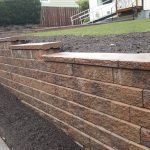

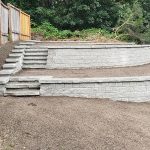
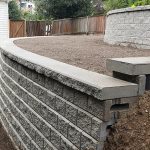
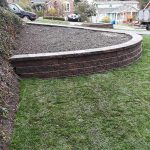

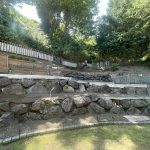
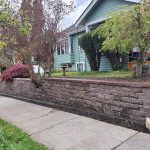

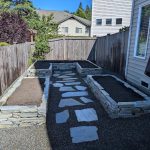
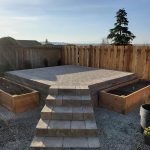
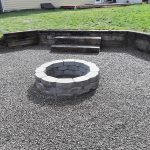
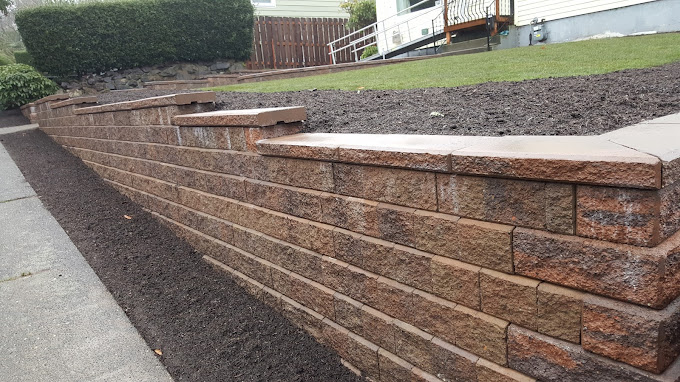
Seattle Retaining Wall Project Options
1. Type of Retaining Wall
- Segmental Retaining Wall
- Gravity Wall
| Feature | Segmental Retaining Wall | Gravity Wall |
|---|---|---|
| Construction Method | Built using interlocking concrete blocks that fit together without mortar. | Built using large, heavy materials like stone, concrete, or precast blocks, relying on weight for stability. |
| Use Cases | Flexible landscaping projects, curved designs, terracing gardens. Ideal for DIY projects. | Small landscaping projects, like garden borders or holding back gentle slopes. |
| Size & Height | Can be used for various heights, including taller walls with the help of geogrid reinforcements. | Best for lower-height walls or smaller slopes; typically not suitable for tall walls. |
| Materials | Precast, interlocking concrete blocks. | Large stones, concrete, or precast blocks. |
| Flexibility | Highly flexible, allows for curved designs and varying heights. | Less flexible, usually built in straight lines due to large material size and weight. |
2. Materials
| Wall Material | Description | Features | Common Uses |
|---|---|---|---|
| Concrete Blocks | Durable and easy to install; available in various shapes and sizes. | Interlocking design popular for DIY and professional projects. | Retaining walls, garden borders, and structural walls. |
| Natural Stone | Offers a rustic, organic appearance; used mainly for decorative purposes. | More expensive and time-consuming to install. | High-end landscaping and decorative features. |
| Brick | Traditional material with a clean, classic look. | Ideal for lower-height walls, often used for garden borders. | Garden walls, borders, and pathways. |
| Timber | Affordable wood walls that are easy to construct. | Best for lower walls; prone to rot over time. | Landscape borders and lower retaining walls. |
3. Height of Wall
| Wall Height | Description | Common Materials | Common Uses |
|---|---|---|---|
| Low (1-3 feet) | Ideal for garden beds, small slope stabilization, or defining features. | Brick, timber, small concrete blocks. | Flower beds, decorative borders, and minor elevation changes. |
| Medium (4-6 feet) | Appropriate for moderate slopes or terracing. | Interlocking blocks, stone, larger concrete blocks. | Terraced gardens and moderate landscape changes. |
| High (7+ feet) | Used for steep slopes or when structural support is necessary. | Poured concrete, sheet piles, large stone blocks. | High retaining walls requiring professional engineering. |
| Tiered Walls | Stepped walls used to reduce soil pressure and visual mass. | Varied materials based on design; often stone or concrete. | Large retaining applications and visual landscaping features. |
4. Wall Finish and Aesthetic
- Natural Stone Finish:
- Achieves a rustic, organic look that blends well with nature.
- Often more expensive, but adds texture and a premium feel to the landscape.
- Smooth/Polished Concrete:
- Offers a sleek, modern look, often used in contemporary designs.
- Ideal for minimalistic landscapes or urban environments.
- Textured Concrete Blocks:
- Many concrete blocks come with decorative faces that mimic stone or brick.
- Provides a high-end look without the cost of natural stone.
- Wood/Timber Appearance:
- Provides a warm, natural look.
- Often used for informal or naturalistic landscapes but requires maintenance to prevent rot.
5. Drainage Solutions
| Drainage Feature | Description | Function | Common Uses |
|---|---|---|---|
| Weep Holes | Small holes built into the retaining wall. | Allows water to escape, preventing pressure buildup behind the wall. | All types of retaining walls for effective water management. |
| Perforated Drain Pipe (French Drain) | A pipe with small holes wrapped in gravel or fabric. | Directs water away from the wall to prevent water damage. | Used behind retaining walls and in landscaping for drainage. |
| Backfill with Gravel | Layer of gravel or crushed stone placed behind the wall. | Facilitates drainage and prevents hydrostatic pressure buildup. | Common in all retaining wall constructions for improved drainage. |
| Geotextile Fabric | Porous fabric placed between soil and gravel backfill. | Allows water to pass while keeping soil particles out. | Enhances drainage efficiency in retaining walls and landscaping. |
| Drainage Channels or Swales | Small trenches or swales directing surface water away from the wall. | Essential for managing heavy water runoff around larger walls. | Used in larger landscaping projects and commercial properties. |
6. Base/Foundation Material
- Crushed Stone or Gravel Base:
- The most common material used to create a stable foundation for the wall.
- Provides good drainage and prevents settling.
- Concrete Footing:
- Used in walls that require extra stability, such as poured concrete or tall retaining walls.
- Ensures the wall remains stable over time, especially for taller structures.
- Compacted Soil:
- Used for simpler, small walls.
- Requires compaction to prevent settling, but doesn’t provide as much stability as gravel or concrete.
7. Wall Reinforcement Option
- Geogrid:
- A geosynthetic material that is placed between layers of the retaining wall.
- Provides additional stability and reinforcement by spreading the load over a larger area.
- Commonly used in higher walls or walls retaining a large amount of soil.
8. Wall Cap Options
- Flat Cap:
- A smooth, flat top to the wall that creates a finished, clean edge.
- Often made of the same material as the wall (e.g., concrete, stone, or brick).
- Bullnose or Rounded Cap:
- Provides a rounded or beveled edge, which is softer and more decorative.
- Common for walls that will be used as seating areas.
- Stepped Cap:
- Designed to follow the natural slope of the wall or the surrounding landscape.
- Adds visual interest and works well with tiered walls.
- Overhanging Cap:
- A capstone that extends slightly over the edge of the wall.
- Protects the wall from water damage and adds depth to the design.
9. Slope or Terracing Design
- Single-tier Wall:
- A single, straight retaining wall used for a minor change in elevation.
- Simplest design, often used in flat areas with a small slope.
- Multi-tier (Terraced) Wall:
- A series of smaller retaining walls placed at different levels to create terraces.
- Reduces soil pressure, allowing for higher elevation changes without building one large wall.
- Provides space for planting between tiers, making it ideal for landscaping.
- Curved vs. Straight Walls:
- Curved walls follow the contours of the landscape, often adding a softer, natural feel.
- Straight walls provide a clean, structured look and are easier to build.
- Curved walls are more flexible and allow for more creative design elements.
10. Lighting Options
- In-ground Paver Lights (LED):
- Small, recessed lights placed directly in the wall surface.
- Adds subtle lighting for walkways or patios, enhancing nighttime safety and ambiance.
- Pathway Lights:
- Small solar or electric lights that line the path.
- Commonly used to illuminate walkways or garden paths.
- String or Hanging Lights:
- Decorative string lights or hanging bulbs for patios to create a warm, inviting atmosphere.
- Often used for outdoor entertaining spaces.
- Spotlights on Plants or Trees:
- Ground lights that highlight surrounding landscaping, such as trees, shrubs, or water features.
- Adds a dramatic touch, especially for garden walkways.
11. Budget Considerations
- Material Costs:
- Natural stone and poured concrete tend to be the most expensive.
- Timber and gabion walls offer more affordable options but may require more maintenance.
- Labor and Installation:
- Professional installation is typically required for higher, more complex walls (especially for concrete and segmental walls).
- Maintenance:
- Timber may need to be replaced over time due to rot.
- Stone and concrete walls require little maintenance but should be inspected regularly for drainage issues.
12. Custom Projects
| Feature Category | Specific Features | Description |
|---|---|---|
| Water Features | Ponds | Backyard pond for aesthetics and wildlife attraction. |
| Lighting | Light Posts | Outdoor light posts for illumination and ambiance. |
| Fire Features | Fire Pits | Outdoor fire pits for warmth and gathering space. |
| Outdoor Cooking & Dining | Outdoor Kitchens | Fully equipped outdoor kitchens for cooking and entertaining. |
| Outdoor Cooking & Dining | BBQ Grilling Stations | Dedicated spaces for grilling and outdoor cooking. |
| Outdoor Cooking & Dining | Outdoor Bars | Designated bar areas for serving drinks outside. |
| Seating & Relaxation | Patio Enclosures | Covered spaces for year-round outdoor enjoyment. |
| Seating & Relaxation | Garden Bench | Benches placed in gardens for resting and enjoying the view. |
| Seating & Relaxation | Outdoor Couch | Couches designed for outdoor use, providing comfort. |
| Sustainability | Compost Bin | Bin for composting organic waste, promoting sustainability. |
| Landscaping & Decor | Entry Monument | Decorative feature at the entrance of a property. |
| Landscaping & Decor | Front Entry Planter | Planters at the front entrance for flowers and greenery. |

